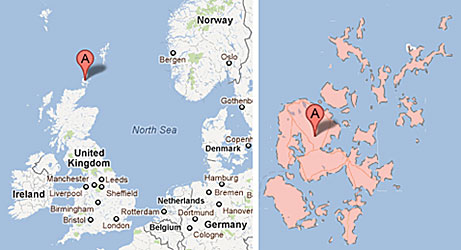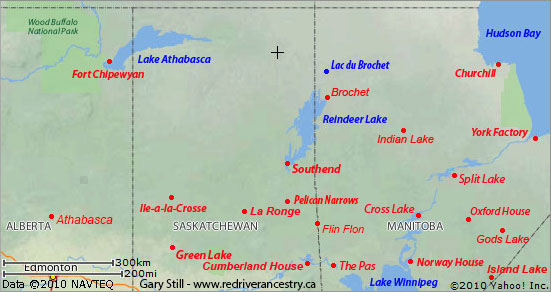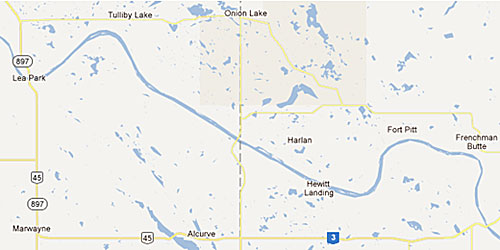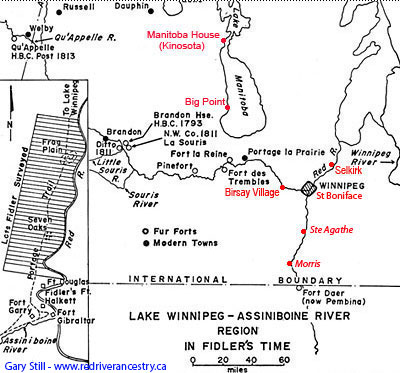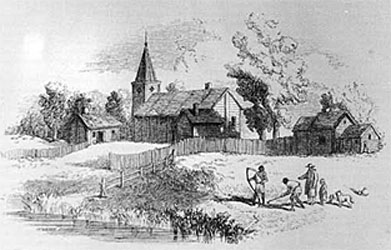MAGNUS SPENCE (1765-1845)
Magnus SPENCE was born in Birsay (Isle of Pomona) in the Orkney Islands of Scotland. The Hudson’s Bay Company Archives (HBCA) indicates that he was born there around 1764 or 1765 (around 1755 according to some sources).
The SPENCE name is a difficult one to research. Numerous family trees indicate Magnus’ parents as Janet ALLEINE & William SPENCE. However, none of these trees provide plausible evidence to support this. Others (uncorroborated) claim his parents were Margaret HARVIE & Nichol SPENCE. Until someone can provide some tangible clues, I remain skeptical. If anyone can provide us with enlightenment, I am sure there are many descendants who would be most grateful.
A = Orkney Islands (Google Maps)
Magnus joins the Hudson’s Bay Company In 1783 Magnus (around 18-19 years old) began his career with the Hudson’s Bay Company (HBC) as a Labourer at York Factory on Hudson Bay. He soon became a Canoe Man (Steersman), work that would have taken him inland during the summer months. Winters were probably spent at York.
The HBC had little success recruiting Canadians to paddle their canoes. Instead of voyageurs (French), the men paddling HBC canoes were 'canoe men', mostly recruited from the Orkney Islands north of Scotland. (The Orkney port of Stromness was the last port of call for HBC ships before crossing the Atlantic.) Life in the Orkneys was tough and cold and the Orkneymen proved themselves more suited to the conditions in Rupert's Land than Londoners. Orkneymen were considered more sensible and hardworking by their English employers than the rash and indolent French Canadians. Orkneymen were also seen as likely to smuggle and too prone to protect each other from the Company. (From the Northwest Journal)
From 1786 to 1803 William TOMISON (1739-1729) became the "Inland Master", leading the HBC competition against the North West Company (NWC), along the Saskatchewan. Magnus undoubtedly worked under TOMISON during the first 10 years or more of his career, so by looking at this man’s biography we can get a feel for what his life as a voyageur was like during that period. ** MORE ABOUT WILLIAM TOMISON in DCBO Magnus and a Cree Woman named Christiana
By 1790 Magnus would have been about 25 years old. We know that he began a life-long relationship with an Indian woman (possibly Cree) named Christiana around this time. From 1791 to 1795 the HBCA indicates he was a Steersman and “linguist” (interpreter), suggesting that by this time he was already in a relationship with Christiana from whom he undoubtedly learned this skill.
Edmonton
From 1795 to 1803 the HBCA indicates that Magnus was posted to Edmonton (his home base) and that he was a linguist to Blackfoot Indians. Although he was based at Edmonton, undoubtedly his work as a voyageur kept him on the move during the summer months. How he learned the Blackfoot language is not very clear.
In the summer of 1795 Angus SHAW (-) of the NWC had Fort Augustus (Fort Saskatchewan) built, further up the river from Fort George (near Lindbergh) on the North Saskatchewan. The next autumn the HBC built Edmonton House near Fort Augustus, where the Sturgeon River meets the North Saskatchewan. It was named Fort Edmonton (also called Fort-des-Prairies by the Métis) by William TOMISON, the Inland Master (Magnus’ boss) who headquartered there until 1799. (In 1801 both of these forts were moved upstream to present day Edmonton)
HBCA: Magnus SPENCE was described as a steady, careful servant and good linguist; "a better servant is not in the Company's employ particularly in the Station he fills.”
Sons John and Andrew were apparently born in the 1790’s. The HBC Archives include both as children but no actual birth-dates are provided.
Fort Vermilion and Fort Pitt
Old Fort Vermilion was located along the North Saskatchewan River in the vicinity of Lea Park (AB)
Between about 1803 and 1808 daughters Mary, Christiana and Jane were born. Many years later, when they applied for their Scrip, Mary & Jane indicated they were born at Old Fort Vermilion, near Fort Pitt. Actually, Fort Pitt wasn’t established until about 1829. In any case, it is perhaps unimportant to know precisely when and where they were born. As a voyageur, Magnus and his family would have travelled extensively up and down the North Saskatchewan, having no permanent residence during that period.
In 1808 the rival NWC and HBC both built adjoining posts on the North Saskatchewan River, opposite the mouth of Vermilion River, Alberta. By 1810 both of these forts were abandoned and both companies rebuilt new posts in the Edmonton area.
Son Magnus Jr. is said to have been born around 1811, probably at Edmonton where Magnus was based until 1815.
Selkirk Settlers begin to Arrive
Beginning in 1811 Lord SELKIRK’s Settlers began arriving at York Factory, bound for Red River. On August 30, 1812 Miles MACDONELL (1767-1828), the new Governor of Assiniboia, arrived at the junction of the Red and Assiniboine rivers (the Forks) with the first group of Selkirk Settlers, sent ahead to prepare the way for more to come. They were accompanied by Peter FIDLER (1769-1822) who had just returned to York from a year’s furlough in England, newly assigned to assist the new settlers by surveying river lots and helping them build their houses. At the same time FIDLER was placed in charge of Brandon House where he established his home base and settled his family. Two months later a second party of settlers led by Owen KEVENY arrived at the Forks. It was too late in the season to seed crops or to build houses, so this group proceeded on to Pembina where FIDLER was building Fort Daer, and badly needed provisions were available to see them through the winter of 1812-13.
Around 1812 alleged son John married Catherine TCHE-TCHIT, a Cree Indian. His son, Jean Baptiste was born around that time in Cumberland House. More information is being sought to validate the premise that Jean Baptiste was a son of Magnus. ** MORE ABOUT JEAN BAPTISTE SPENCE
On Jan 8, 1814, anticipating the arrival of yet another large group of settlers and seeking to solve the colony’s food problems once and for all, Miles MacDONELL issued his historic Pemmican Proclamation. He would have been at Pembina at that time. The proclamation prohibited the export of provisions of any kind from within the limits of Assiniboia without a special license from the Governor (himself). For two winters the Métis had provisioned the colonists with bison meat, so this severe measure was considered an insult, not only to them but to the NWC.
In July of 1814 the NWC held its annual meeting at Fort William where an indignant William McGILLIVRAY (1764-1825) declared regarding MacDONELL’s actions "It is the first time the Nor'Westers have permitted themselves to be insulted". From that day there would be civil war in the North-West.
On Aug 30, 1814 Cuthbert GRANT (1796-1854) arrived at Fort Gibraltar (Winnipeg) with Duncan CAMERON (1764-1848). A great display of hostility and intimidation was put on by their men, and CAMERON (in an Officer’s uniform) actively persuaded many of the Settlers to accept a NWC offer of transportation out of the colony to the Canadas.
Magnus SPENCE at Fort Qu’Appelle and Brandon House
In 1815-16, the HBC Archives indicate that Magnus was relocated (from Edmonton) to the Company’s Fort Qu’Appelle which was located very close to the rival NWC post of Fort Esperance, home base of Cuthbert GRANT, Captain of the Métis soldiers, not a safe place for an HBC man to be. In the spring or summer of 1816 it appears that Magnus decided to move his family to Brandon House, where Peter FIDLER was in charge and where many other HBC employees from the region had gathered together for safety during the Métis hostilities. Many of these men were fellow voyageurs from the Orkneys who were not happy campers during this period.
On June 19, 1816, The Battle of Seven Oaks occurred with Governor SEMPLE and twenty of his men killed on Frog Plain. Cuthbert GRANT and the Métis then took Fort Douglas. Magnus SPENCE and his fellow canoe men began to resent the situation they found themselves in. Their work conditions and salaries were intolerable and some of them threatened mutiny. Most of them did not share FIDLER’s dogged loyalty to the HBC. The ‘Honorable Company’ in fact was notoriously discriminatory when it came to its treatment of its half-breed employees (including Peter’s own children); whites were always favored when it came to promotions, etc. Peter FIDLER himself was a reluctant participant in the struggles that unfolded. These men all had Indian wives, and consequently half-breed children. Their wives had family ties with native families from the region of Hudson Bay and some were probably even related to each other (French Métis and English-speaking half-breeds as well). Nevertheless, during the conflict FIDLER considered it necessary to actually fire some of these men, notably including Humphrey FAVEL, Tom FAVEL, Magnus SPENCE and John LYONS.
Birsay Village, “Orkney Town”
Birsay Village, located along the Assiniboine River, later became St Francois Xavier
Finally, in the fall of 1817 the Red River Rebellion came to an end when Lord SELKIRK’s de Meuron soldiers recaptured Fort Douglas; Cuthbert GRANT was arrested and the Métis were forced to retreat.
Magnus was over 60 years old when his dismissal occurred (he apparently was later re-hired). In the winter of 1817-18, jobless and weary from their thankless toil and strife, a group of Orkney canoe men who had been fired sought a more pleasant and peaceful environ to retreat with their families. For a short period this would be a little settlement that was named Birsay Village or “Orkney Town”; named after his homeland by Magnus SPENCE, the elder who led them there.
In May of 1819, Peter FIDLER made a map of Red River District, recording the settlement of Birsay Village. That spring he counted eight males, two females and 13 children, six boys and seven girls. Only Magnus SPENCE and James MONKMAN had a wife and family listed against their names. The other wives and children are likely with the Indian side of their families at this time.
Whooping cough and measles hit Orkney Town; several deaths were recorded. To add to their misery, swarms of grasshoppers destroyed their crops. By mid-September of 1819, the aforementioned families from Brandon had abandoned their new village. Soon after, French Canadian Freeman and Métis families from Pembina moved in, recreating the settlement as St Francois Xavier.
Many of the Birsay villagers moved their families to the vicinity of Sugar Point on the Red River north of Kildonan where they would become the first residents of the Village of Mapleton (near Selkirk).
St John’s Church, Upper Settlement, Red River 1820’s
On Oct 14, 1820, Rev John WEST arrived at Fort Douglas (Wpg) where he established a church at St Johns. November 26 and 27, 1820 were very significant days in the lives of the SPENCE and WHITFORD families. John SPENCE, at the age of 28, was baptized by Rev WEST. His sisters (17 year old Mary and 16 year old Christie) were baptized the same day. The very next day, John SPENCE married Jane TAIT, Mary married James WHITFORD and Christie married Peter WHITFORD, James' brother. James & Peter were sons of Sarah & James Peter WHITFORD (1766-1845). ** MORE ABOUT JAMES PETER WHITFORD
Magnus Retired after the HBC-NWC Merger
In 1821 union of the North West Company (NWC) and the Hudson’s Bay Company (HBC) occurred, ending years of bitter rivalry for dominance of the fur trade in Western Canada. After the merger, almost 1,300 employees lost their jobs (including Magnus SPENCE) since the single HBC organization that emerged had no need for most of their voyageurs and retired fur traders. Sir George SIMPSON (1786-1860) became the Governor of Rupert’s Land. On May 20, 1822, SIMPSON reported to the board of governors of the HBC that he had established a fort at the junction of the Red and Assiniboine Rivers. He named it Fort Garry (the Upper Fort). Around this fort was to grow the city of Winnipeg.
When the Red River Census of 1827 was taken, Magnus SPENCE was recorded as age 65; married with two adult sons (Magnus Jr. and Andrew) and a daughter (Jane). He had a house and a canoe and had four acres of land under cultivation.
On Oct 30, 1827 son Andrew married Susette LEUNAY.
On May 12, 1845 Magnus SPENCE SR died in St Andrews Parish.
Link for Discussion: ** DISCUSSIONS about the FAMILY of MAGNUS SPENCE SR
========================== Family Details ==========================
Children: ?1. c1795 JOHN SPENCE (m1. Catherine (Cree) TCHE-TCHIT; m2. Jane TAIT) 2. c1800 ANDREW SPENCE (m. Suzette LEUNAY) 3. c1803 MARY NANCY SPENCE (m. James WHITFORD) 4. 1804 CHRISTIANNA "CHRISTIE" SPENCE (m. Peter WHITFORD) 5. 1808 JANE (JANET) SPENCE (m. Henry HOWSE) 6. 1811 MAGNUS SPENCE JR (m. Sarah FAVEL)
|

